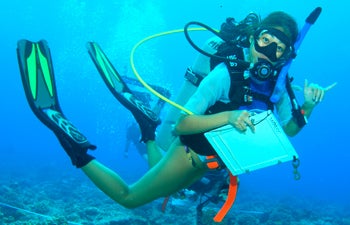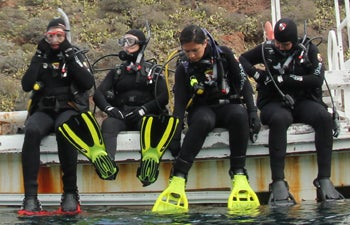Taking the Plunge
USC Dornsife students are diving into this year’s Maymester courses.
After taking a Spring semester course on the physics, physiology, safety and methodology of scientific diving, 26 undergraduates will dive in the exotic locale of Guam and Palau and study environmental issues.
“Integrated Ecosystem Management in Micronesia,” is a four-unit, four-week Maymester course that began May 14.
Before students could take the Maymester class, they had to have completed “Introduction to Scientific Diving” a two-unit course in the Spring that took place in a classroom, a pool on University Park campus and in the Pacific Ocean near the Wrigley Marine Science Center on Catalina Island, housed in USC Dornsife, where each student conducted 29 dives.
The Maymester course has seen a steady increase in nearly three years, said David Ginsburg, a lecturer in environmental studies and an instructor in the course.

Lauren Otaguro, a senior majoring in neuroscience and minoring in environmental studies in USC Dornsife, conducts underwater research during the 2010 Maymester trip to Guam and Palau. Photo by Gerry Smith.
When it launched in 2010, the class enrolled 14 students compared to 24 last year and 26 this year.
“We’ve never had so many undergraduates doing scientific diving,” Ginsburg said.
USC Wrigley Institute for Environmental Studies dive safety officer Gerry Smith said students are jumping at the chance to dive in an exotic location.
“They’re very highly motivated,” Smith said. “When you have a trip to Guam and Palau as a reward, you get an incredibly enthusiastic response.”
Smith will accompany the students on their trip to the Pacific Islands, where each will complete 20 dives. He said the undergraduate students must meet extremely strict standards in order to pass both the Maymester and Spring courses.
“We have some of the most rigorous standards in the academic diving community,” Smith said.
The Spring course involved training sessions on University Park campus’ Physical Education Building pool then additional dives off Catalina Island at the Wrigley Marine Science Center. One part of the island training involves a 400-meter swim in the ocean.
“These are American Academy of Underwater Sciences standards for water skills,” Smith said. “Before we let the students dive independently, they must show sufficient stamina and skill to rescue themselves and an injured buddy.”
The leaders for both courses are Jim Haw, Ray R. Irani Chairman of Occidental Petroleum Chair in Chemistry, professor of chemistry and director of environmental studies, Ginsburg and Smith. All are AAUS-certified divers and have advanced certification from the National Association of Underwater Instructors. Haw and Ginsburg have leadership certifications and Smith is certified as a NAUI Scuba Instructor, the association’s highest credential.
In addition to setting high academic and diving standards for the students, the course maintains high safety standards.

The Maymester class in training at the Wrigley Marine Science Center dock on Catalina Island. Photo by Jim Haw.
For example, if there are 26 students in the water, there are nine USC staff with them: three instructors, three dive masters or assistant instructors, and three dive master candidates, Smith said.
The in-classroom instruction covered all aspects of diving — the physics and physiology of diving, plus the incorporation of scientific diving into research projects.
“It has all the rigor of any other course on campus,” Ginsburg said.
At least five students who went on the first Maymester trip to Guam and Palau are continuing to use their dive training in master’s and Ph.D. programs. Instructors are working to recruit students early in their academic career so scientific diving can be a bigger part of their undergraduate experience.
Emily Lu, an environmental studies sophomore taking the Maymester course, wants to gain a deeper understanding of the ecological challenges facing Guam and Palau. Inspired by the program, she is considering research as a possible career path.
“Most students sit in a classroom and learn about the issues,” Lu said. “But we get to see the environmental issues firsthand and experience them.”
Follow students on their journey through their blog, posted in Scientific American.
More information on the scientific diving program can be found here.